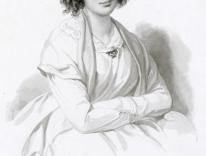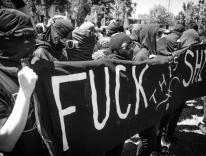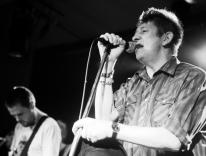I am a Connecticut Yankee transplanted from the Midwest. I have never worshiped the sun, never sought the heat. But this past June I headed due and deep south on a sort of personal pilgrimage, to hear and see the world’s master of choral music, Robert Shaw. At eighty-two, Shaw is not only the grand old man of American classical music, he is also one of the most adventuresome conductors working anywhere.
Shaw has been a household name for fifty years. Millions of Americans remember the Robert Shaw Chorale of the 1950s and 1960s. They heard it on tour or bought the records. Still others remember his work on the radio and with Fred Waring. But even then Shaw was leading choruses for Toscanini, teaching at Juilliard, and founding the Collegiate Chorale. An intensely serious musician, he has always sought the most noble and difficult work. Thus, at the peak of his own chorale’s popularity, he went to work with the Cleveland Orchestra, running its choral program so that he could learn from the legendary George Szell. In fact, Shaw tailored his chorale’s tours around the Cleveland Orchestra’s schedule.
In those years, Shaw was setting a new standard for vocal music in America-while popularizing it. He had a deep and widespread impact on two generations of community, high-school, and college choral direction. Working with Alice Parker, he created the now-enshrined arrangements of American Negro spirituals and Appalachian folk songs. The Robert Shaw Chorale recorded these, along with Irish folk songs, sea chanteys, Stephen Foster tunes, and Christmas music. These became the canon of popular American choral music. And because of the popularity of the chorale, Shaw was able to introduce middle America to something else-the monumental works of choral music: the Mozart Requiem, Handel’s Messiah, Bach’s Passions, etc. He brought these to high school gyms in midsize towns throughout America, alternating them with programs of spirituals and glee-club repertoire.
Shaw was the first to lead a professional performance of the Bach B Minor Mass in New York, and he made the first American recordings of it and the Brahms German Requiem. He toured the B Minor Mass with the chorale, which many thought was insane, but sold out the bookings even before leaving New York. And he took it to Russia for a historic performance that is said to have deeply affected the musical life of that country. Shaw was also the first in America to perform Benjamin Britten’s War Requiem-a work he has continued to champion-and he commissioned Paul Hindemith’s "When Lilacs Last in the Dooryard Bloomed."
All this is an amazing legacy, but it constitutes only part of Shaw’s life in music. For what is less well documented is Shaw’s work since he disbanded the chorale thirty years ago and moved to Atlanta as music director of the Atlanta Symphony Orchestra. Not only did he build a good regional symphony into a world-class orchestra, but he:
Championed modern classical music;
continued to compile an incredible list of recordings (made up, in part, of near-definitive performances of great works, along with obscure choral works that otherwise might be lost to the recording world);
changed the musical geography of the South, lifting standards but also integrating his programming and his orchestra;
and in recent years, pursued a second-or third-career as a musical patriarch and rabbi.
In November of last year, I scheduled a business trip around a Shaw concert with the Atlanta Symphony and Chorus. Shaw is now its music director emeritus and conductor laureate. The maestro mounted an extraordinary program: BŽla Bart-k’s "Cantata Profana," which Shaw premiered in New York some forty years before; Samuel Barber’s "Prayers of Kierkegaard"; and Ralph Vaughan Williams’s "Dona Nobis Pacem." These are modern pieces, and all are choral, making them doubly hard sells. But the Atlanta audience did not find the program obscure, high brow, or inaccessible. Instead, three performances were virtual sellouts and the audiences roared.
Afterward, Shaw recorded the pieces for Telarc (80479), causing more than one critic to admire the vocal product and the conductor’s nerve. Many younger conductors wouldn’t dare attempt such a program, and no other conductor in America has the clout to get such pieces onto disc-and then to sell them. This year Shaw won his fourteenth Grammy. I would not be surprised if this new recording brings him a fifteenth.
My June pilgrimage was to Greenville, South Carolina, where The Robert Shaw Choral Institute has relocated from southwestern France. The institute has had a number of sponsors over the years, including Emory, Ohio State, and Boston universities. It is now sponsored by Furman University, a physically beautiful school in Greenville with an outstanding music program. If Furman sticks with Shaw, it will be known worldwide.
The institute consists of two weeks of intensive score study and preparation with Shaw, culminating in two concerts. The two programs I heard in Greenville were even more extraordinary than what I had heard in Atlanta. The first program was held at Greenville’s performing arts center. The second was at the First Baptist Church. Both were followed by encores of Shaw/Parker spirituals.
The first program consisted of the Bach motet "Singet dem Herrn" ("Sing to the Lord a New Song"), the Mozart Mass in C Major (or "Coronation Mass"), and the Haydn Mass in D Minor (or "Lord Nelson Mass"). The second program was English, modern, and without orchestra. It consisted of the Mass in G Minor by Ralph Vaughan Williams; Requiem, by Herbert Howells; and four pieces by Benjamin Britten: Selections from "A.M.D.G.," from the opera Gloriana, and from "Sacred and Profane"; and "Rejoice in the Lamb." It was the most intimate and perhaps most deeply moving concert of classical music I have ever heard. The listener did not want to leap out of the seat and yell "Bravo!" but simply to sit (or perhaps stand) in appreciative silence.
The first concert was sublime. But it is not possible for me to convey how poignant and profoundly beautiful the second performance was. Many factors converged. It was in a smaller space-a church, not a concert hall. There were only the choir and Mr. Shaw, no horns or strings. The performance of the Howells Requiem was dedicated to a member of the choir who had died just two days before, after what Mr. Shaw described as "a frighteningly brief" bout with cancer. The piece itself is about the death of Howells’s only son. The composer wrote it, then tucked it away for almost forty-five years. This was "the quiet music of the Holy Ghost" in a hypnotic performance. One could sense the absolute unity of the choir in total sync with its conductor. Not only was every eye on him when not on the music, but a sort of collective clock seemed to have the singers and conductor moving through the music as one unit, one spirit.
Shaw gave so utterly of himself that it was impossible not to be moved. After a two-and-a-half-hour program, the octogenarian was so exhausted that, accompanied by an aide, he simply left the hall while the audience stood waiting for him to return to take his bow. (Shaw will seldom come to the center of the stage to bow, and if pressed, will do so only once. He typically stands to the side, applauding the orchestra, soloists, and chorus, and sometimes singling out individuals for acclaim.)
Finally, at the First Baptist performance, Shaw annotated virtually every piece with his humorous, salty, deeply felt commentary, making the performance all the more personal. He was teaching the audience as well as the singers he had been instructing all week.
Top of the Ninth
In September, I attended performances of the Beethoven Ninth Symphony, Choral Fantasy, and Missa Solemnis at the Kennedy Center in Washington, D.C. The National Symphony Orchestra and the Choral Arts Society of Washington presented a Beethoven festival, led by Mr. Shaw.
Although the maestro had canceled appearances during the summer for reasons of health, Shaw seemed quite fit at the Kennedy Center. Reviewing the performance, Washington Post critic Tim Page described Shaw as being "at the peak of his powers," and noted that "after some thirty-five years of exposure to the Ninth, I cannot remember having heard the choral finale sung so magnificently...big, booming, full-throated, eternally exultant, yet impeccably nuanced." I concur. I do not expect to hear such a performance again in my lifetime.
k.c.b.
What is the famous "Shaw sound"? Precision plus spirit. After Greenville, I bought a non-Shaw recording of the Howells Requiem. It was very fine, but the sound was English, boyish, and sweet. When Shaw’s choir sang the piece, it had been anguished, searching, and, finally, a fluid, confident prayer of consolation.
What makes "the Shaw sound"? Start with lightness and precision. Shaw knits together 160 singers to sound like 16. When he performs Bach, there is quickness yet all Bach’s passion and fervor remain. There is also a singular velvety quality; an almost dancing soprano sound, never screechy or shrill; and a rich, hooty bass tone that works as a sort of Verdi-like foundation. No one gets basses to sound the way that Shaw’s do. All this is accomplished according to Shaw’s well-honed method: an emphasis on rhythm and on count-singing; and breaking down the music into separate tasks, so that the notes, rhythm, enunciation, dynamics, and color are all handled separately. Amazingly, in a week’s rehearsal time, Shaw can get "the sound" with a choir he is guest conducting.
Another factor in creating the sound is Shaw’s meticulous editing of the scores: he gives dynamic marking to virtually every note, for every voice and instrumental part. The singers never just "hang around." There is always something to do (even if it can’t easily be done). Shaw builds an internal unity in the choir from its mutual commitment, effort, and technical drill.
But there still remains an X factor, something beyond the maestro’s considerable bag of technical tricks. It has to do with Shaw’s teaching style. He has the ability to imagine and then explicate the music for the musicians. With verbal finesse, he inspires them to rise to the very top of their abilities-and maybe a little above them. Voices, particularly, can be manipulated by the power of suggestion, and Shaw’s suggestions are powerful. People who sing or play under him describe the process of "reaching for the music" or of "unfolding" it. Shaw gives them a road map to the heart of the composer.
Rather than playing the dictatorial conductor, Shaw approaches musicians as collaborators who must fashion the product among themselves. He does not simply hand them the music, but helps them to rediscover it.
I believe the X factor in the Shaw technique/sound is derived from human awe. When a Shaw chorus sings of the Crucifixion, it lays Christ in the tomb before you. When it sings of the Resurrection, it soars.
Since his retirement as music director of the Atlanta Symphony in 1988, Shaw has spent much of his time teaching in short residences at American universities, and conducting the two ambitious choral workshops that he established for teachers and conductors. One of these is the Robert Shaw Choral Workshop at Carnegie Hall. Held each January, it culminates in a Carnegie recital. The other is the institute at Furman. Through these workshops and recitals, Shaw continues to promulgate his well-honed musical principles:
Music should be made for love, not money. (This is one reason Shaw is so devoted to working with amateur groups.)
A choir is a community, in fact a moral community whose activity is akin to what the discourse was for Socrates and his students. For Shaw, a choir achieves a unity generally not possible today in politics or religion: All members work for a greater good, but individuality may still flourish.
The goal of score study and performance is to get back to the composer’s original intent. Performance is not show business but an act of faithfulness.
Thus a whole cohort of music teachers and conductors has been schooled in Shaw’s ideas, methods, and passion. This may constitute an even greater musical legacy than Shaw’s arrangements and the folk canon of the Robert Shaw Chorale era.
Shaw is not a churchy man, but to me he seems a deeply religious one. He conducts the great sacred choral texts not as aural ornamentation, but as truth. He told Martin Goldsmith of National Public Radio that "music is a sacrament, when it’s right."
Shaw’s singers know that this man with sixty years of experience (ranging from work with Bruno Walter to Philip Glass), ornery wit, and magnificent humanity, can lead them to the very heart of Bach, or Brahms, or Mozart. One senses they would follow him anywhere. As would those of us who envy them.
Please email comments to [email protected] and join the conversation on our Facebook page.
Share
Previous Story
So far...
Next Story
The whole picture


